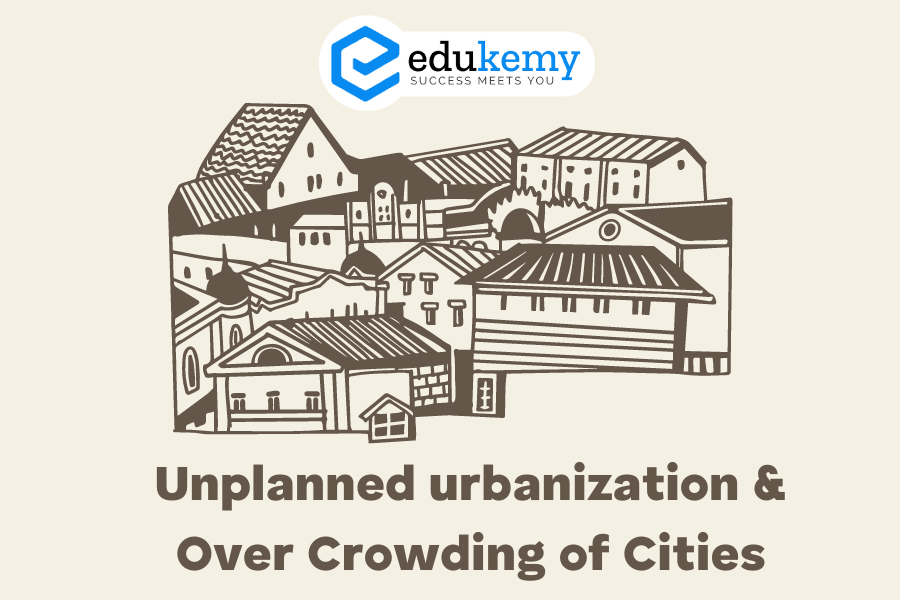
Unplanned urbanization and the consequent over-crowding of cities have emerged as formidable challenges in the contemporary global landscape. Rapid population growth, coupled with insufficient urban planning and infrastructure development, has led to the proliferation of informal settlements, inadequate housing, strained public services, and environmental degradation in urban areas worldwide. This unplanned expansion not only exacerbates socio-economic disparities but also poses significant threats to public health, safety, and overall quality of life. As urban populations continue to swell, addressing the root causes and mitigating the impacts of unplanned urbanization and over-crowding stands as an urgent imperative for sustainable development and the well-being of billions living in cities.
Contents
- 1 Unplanned urbanization
- 2 Over Crowding
- 3 Creation of Slums
- 4 FAQs on Unplanned Urbanization & Overcrowding of Cities
- 4.1 1. What is unplanned urbanization?
- 4.2 2. What are the consequences of unplanned urbanization?
- 4.3 3. How does overcrowding affect cities?
- 4.4 4. What are the solutions to address unplanned urbanization and overcrowding?
- 4.5 5. What role can technology play in managing urbanization and overcrowding?
- 5 In case you still have your doubts, contact us on 9811333901.
Unplanned urbanization
- Various factors responsible for the process of urbanization like migration, better economic opportunities led to settling down of people either in already densely populated cities or the fringe areas around the cities.
- This rapid urbanization leads to the development of cities without any urban planning and eventually that becomes unsuitable for living. It poses a serious threat to the development in terms of delivery of services and living conditions.
- Also, rapid urbanization forces government to build cities which actually lacks proper infrastructure, public facilities and employment opportunities.
Over Crowding
- In major cities in India like Mumbai, Kolkata, Pune and Kanpur, somewhere between 85% and 90% of households live in one or two rooms. In some households, five to six people live in one room.
- Over-crowding encourages deviant behavior, spreads diseases and creates conditions for mental illness, alcoholism etc. One effect of dense urban living is people’s apathy and Indifference.
- Overcrowding is a situation in which too many people live in too little space. Overcrowding is a logical consequence of overpopulation in urban areas.
- It is naturally expected that cities having a large size of population squeezed in a small space must suffer from overcrowding. This is well exhibited by almost all the big cities of India.
- For example, Delhi has a population density of 11,320 persons per sq km (Census 2011) which is the highest in India. This is the overall population density for the Union Territory of Delhi.
- This leads to tremendous pressure on infrastructural facilities like housing, electricity, water, transport, employment, etc. Efforts to decongest Delhi by developing ring towns have not met with the required success.
Creation of Slums
- There is acute shortage of housing in urban areas and much of the available accommodation is of sub-standard quality.
- This problem has worsened over the years due to rapid increase in population, fast rate of urbanization and proportionately inadequate addition to the housing stock.
- With large scale migration to urban areas many find that the only option they have is substandard conditions of slums.
- Slums are characterized by sub-standard housing, overcrowding, lack of electrification, ventilation, sanitation, roads and drinking water facilities.
- They have been the breeding ground of diseases, environmental pollution, demoralization and many social tensions.
- As per the census 2011, 17% of the urban population in India lives in slum which is expected to increase rapidly considering the huge migration from rural to urban area. Notably, this percentage is even higher in some of the cities. For e.g., the ratio is more than 50% in Greater Mumbai.
FAQs on Unplanned Urbanization & Overcrowding of Cities
1. What is unplanned urbanization?
- Unplanned urbanization refers to the haphazard growth of cities without adequate consideration for infrastructure, housing, or environmental sustainability. It often results in congestion, inadequate services, and social disparities.
2. What are the consequences of unplanned urbanization?
- Unplanned urbanization leads to overcrowding, strain on resources, increased pollution, traffic congestion, and inadequate access to basic services like water, sanitation, and healthcare. It also exacerbates social inequalities and can contribute to environmental degradation.
3. How does overcrowding affect cities?
- Overcrowding in cities strains existing infrastructure, leading to increased pollution levels, traffic congestion, and housing shortages. It also poses challenges in providing essential services like healthcare and education, while simultaneously increasing social tensions and crime rates.
4. What are the solutions to address unplanned urbanization and overcrowding?
- Solutions include effective urban planning, zoning regulations, investment in infrastructure, affordable housing initiatives, promotion of public transportation, and sustainable development practices. Additionally, decentralization efforts to develop secondary urban centers can alleviate pressure on major cities.
5. What role can technology play in managing urbanization and overcrowding?
- Technology can aid in urban planning through data analytics, smart city initiatives, and the implementation of IoT (Internet of Things) devices for better resource management. It can also facilitate telecommuting and remote work, reducing the need for physical presence in overcrowded cities and distributing economic activities more evenly.
In case you still have your doubts, contact us on 9811333901.
For UPSC Prelims Resources, Click here
For Daily Updates and Study Material:
Join our Telegram Channel – Edukemy for IAS
- 1. Learn through Videos – here
- 2. Be Exam Ready by Practicing Daily MCQs – here
- 3. Daily Newsletter – Get all your Current Affairs Covered – here
- 4. Mains Answer Writing Practice – here

